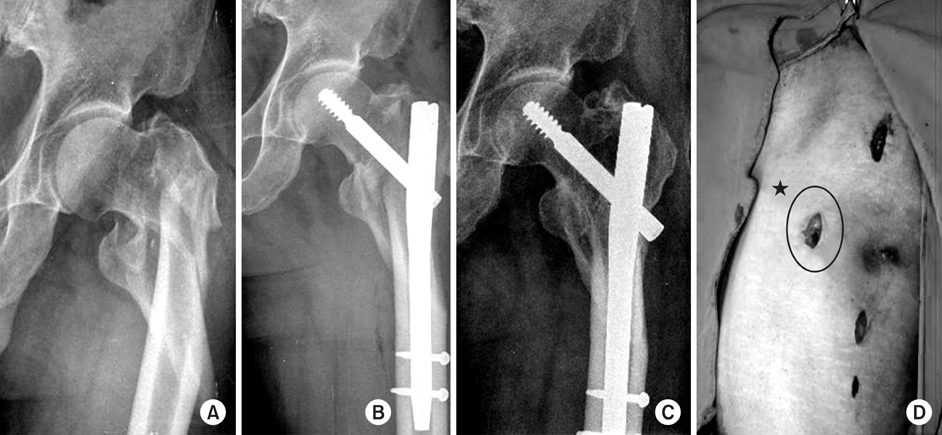J Korean Fract Soc.
2010 Jan;23(1):13-19. 10.12671/jkfs.2010.23.1.13.
Unstable Intertrochanteric Femoral Fracture Treated with Mini-incision Reduction Technique and Intramedullary Nail
- Affiliations
-
- 1Department of Orthopaedic Surgery, Yeungnam University College of Medicine, Daegu, Korea. min1913@hanmail.net
- KMID: 1461567
- DOI: http://doi.org/10.12671/jkfs.2010.23.1.13
Abstract
- PURPOSE
To evaluate the efficacy of mini-incision reduction technique in unstable intertrochanteric femoral fracture treated with intramedullary nail.
MATERIALS AND METHODS
From January, 2005 to December, 2007, we selected 26 patients of unstable intertrochanteric femoral fracture which underwent anatomic reduction by mini-incision reduction technique using various instruments, and treated with intramedullary nail. We evaluated the radiological results with the union time, change of femoral neck-shaft angle and distance of lag screw sliding by follow-up radiography, and the clinical results with the mobility score of Parker and Palmer, Salvati and Wilson hip function scoring system and Jensen index.
RESULTS
The mean union time was 18.9 weeks. The mean changes of femoral neck-shaft angle was 4.1 degree. The mean distance of lag screw sliding was 4.4 mm. Decrease of mobility score of Parker and Palmer, Salvati and Wilson hip function score was showed, and social function score of Jensen maintained 54% compared with preoperative score.
CONCLUSION
Mini-incision reduction technique using various instruments showed satisfactory clinical and radiological results, and we believe that it is a recommendable method in unstable intertrochanteric femoral fracture which manual reduction is difficult.
Figure
Reference
-
1. Adams CI, Robinson CM, Court-Brown CM, McQueen MM. Prospective randomized controlled trial of an intramedullary nail versus dynamic screw and plate for intertrochanteric fractures of the femur. J Orthop Trauma. 2001. 15:394–400.
Article2. Apel DM, Patwardhan A, Pinzur MS, Dobozi WR. Axial loading studies of unstable intertrochanteric fractures of the femur. Clin Orthop Relat Res. 1989. 246:156–164.
Article3. Baumgaertner MR, Curtin SL, Lindskog DM. Intramedullary versus extramedullary fixation for the treatment of intertrochanteric hip fractures. Clin Orthop Relat Res. 1998. 348:87–94.
Article4. Bendo JA, Weiner LS, Strauss E, Yang E. Collapse of intertrochanteric hip fractures fixed with sliding screws. Orthop Rev. 1994. 30–37.5. Desjardins AL, Roy A, Paimont G, et al. Unstable intertrochanteric fracture of the femur, A prospective randomised study comparing anatomical reduction and medial displacement osteotomy. J Bone Joint Surg Br. 1993. 75:445–447.
Article6. Dimon JH, Hughston JC. Unstable intertrochanteric fractures of the hip. J Bone Joint Surg Am. 1967. 49:440–450.
Article7. Evans EM. The treatment of trochanteric fractures of the femur. J Bone Joint Surg Am. 1949. 31:190–203.
Article8. Guyton JL. Canale T, editor. Intertrochanteric fractures of the hip. Campbell's operative orthopedics. 1998. 9th ed. St Louis: Mosby;2188–2190.9. Haidukewych GJ, Israel TA, Berry DJ. Reverse obliquity, fractures of the intertrochanteric region of the femur. J Bone Joint Surg Am. 2001. 83-A:643–650.
Article10. Hardy DC, Descamps PY, Krallis P, et al. Use of an intramedullary hip-screw compared with a compression hip-screw with a plate for intertrochanteric femoral fractures. A prospective, randomized study of one hundred patients. J Bone Joint Surg Am. 1998. 80:618–630.
Article11. Herrera A, Domingo LJ, Calvo A, Martínez A, Cuenca J. A comparative study of trochanteric fractures treated with the gamma nail or the proximal femoral nail. Int Orthop. 2002. 26:365–369.
Article12. Carr JB. The anterior and medial reduction of intertrochanteric fractures: a simple method to obtatin a stable reduction. J Orthop Trauma. 2007. 21:485–489.
Article13. Jensen JS. Determining factors for the mortality following hip fractures. Injury. 1984. 15:411–414.
Article14. Kaufer H, Matthews LS, Sonstegard D. Stable fixation of intertrochanteric fractures. J Bone Joint Surg Am. 1974. 56:899–907.
Article15. Koval KJ, Zuckerman JD. Hip fractures: II. evaluation and treatment of intertrochanteric fractures. J Am Acad Orthop Surg. 1994. 2:150–156.
Article16. Olsson O, Ceder L, Hauggaard A. Femoral shortening in intertrochanteric fractures. A comparison between the Medoff sliding plate and the compression hip screw. J Bone Joint Surg Br. 2001. 83:572–578.17. Parker MJ, Palmer CR. A new mobility score for predicting mortality after hip fracture. J Bone Joint Surg Br. 1993. 75:797–798.
Article18. Rao JP, Banzon MT, Weiss AB, Rayhack J. Treatment of unstable intertrochanteric fractures with anatomic reduction and compression hip screw fixation. Clin Orthop Relat Res. 1983. 175:65–71.
Article19. Sadowski C, Lübbeke A, Saudan M, Riand N, Stern R, Hoffmeyer P. Treatment of reverse oblique and transverse intertrochanteric fractures with use of an intramedullary nail or a 95 degrees screw-plate: a prospective, randomized study. J Bone Joint Surg Am. 2002. 84:372–381.
Article20. Salvati EA, Wilson PD Jr. Long-term results of femoral head replacement. J Bone Joint Surg Am. 1973. 55:516–524.21. Sarmiento A, Willianms EM. The unstable intertrochanteric fracture: treatment with a valgus osteotomy and I-beam nail-plate. A preliminary report of the hundred cases. J Bone Joint Surg Am. 1970. 52:1309–1318.22. Schipper IB, Steyerberg EW, Castelein RM, et al. Treatment of unstable trochanteric fractures. Randomized comparison of the gamma nail and the proximal femoral nail. J Bone Joint Surg Br. 2004. 86:86–94.23. Lichtblau S. The Unstable Intertrochanteric Hip Fracture. Orthopedics. 2008. 31:792–797.
Article24. Sim JA, Choi JS, Moon DH, Ahn SJ. Treatment using reduction of lateral and posterior displacement in unstable intertrochanteric fractures of the elderly. J Korean Fract Soc. 2005. 18:390–393.
Article25. Yoo JH, Yang KH, Park SY, Won JH, Yoon HK. The treatment of unstable reverse oblique intertrochanteric fractures with proximal femoral nail (PFN). J Korean Orthop Assoc. 2005. 40:733–740.
Article
- Full Text Links
- Actions
-
Cited
- CITED
-
- Close
- Share
- Similar articles
-
- Lateral Positioning for Proximal Femoral Nailing of the Intertrochanteric Fracture: Surgical Technique
- Femoral Neck Fracture After Removal of the Intramedullary Nail for the Fixation of an Intertrochanteric Fracture: Report of 2 Cases
- Comparative Study of Intertrochanteric Fracture Treated with the Proximal Femoral Nail Anti-Rotation and the Third Generation of Gamma Nail
- Treatment of Unstable Intertrochanteric Femoral Fracture with the AO/ASIF Proximal Femoral Nail (PFN)
- Flexible Intramedullary Nailing for Femoral Fractures




